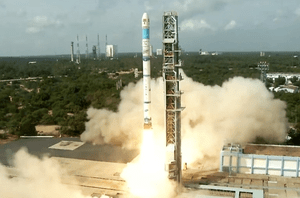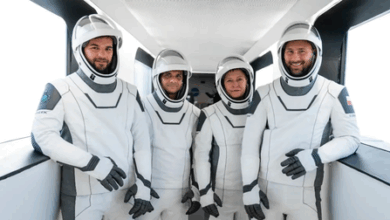
India, on Friday, successfully orbited two satellites with its new rocket – Small Satellite Launch Vehicle (SSLV).
On its third and final developmental flight, the SSLV-D3 put into orbit an earth observation satellite-08 (EOS-08) weighing about 175.5 kg, and SR-0 satellite belonging to the Chennai-based start-up Space Rickshaw.
Speaking about the mission, the Chairman of the Indian Space Research Organisation (ISRO) Dr S. Somanath said: “The third development flight of SSLV has been successfully accomplished. We can declare the process of SSLV development has been completed. We are in the process of transferring the SSLV technology to the industries.”
Somanath also said the satellites have been placed in the orbit planned and there is no deviation.
“The satellite’s (EOS-08) solar panels have been deployed,” Somanath added.
According to S. S. Vinod, Mission Director, a major milestone in SSLV has been achieved.
“The spacecraft (EOS-08) is unique with new technologies. There are 20 new technologies and three new payloads in the satellite,” M. Avinash, Satellite Director said.
ISRO has developed SSLV with a carrying capacity of 500 kg to the Low Earth Orbit (LEO) based on the market trend of going in for smaller satellites.
At about 9.17 a.m. the 34-metre tall and about 119-ton expendable rocket costing about Rs 56 crore broke free of the first launch pad and started its one-way journey upwards.
The rocket with a thick orange flame at its tail slowly gathered speed and went up.
As to the mission’s objectives, ISRO said that it will complete the SSLV Development Project and enable operational missions by Indian industry and the public sector NewSpace India Ltd.
About 13 minutes into its flight, at an altitude of 475 km, the SSLV rocket ejected EOS-08 and about three minutes later the SR-0 was separated.
For the city-based space sector start-up Space Rickshaw, the SR-0 will be its first satellite.
“We will be making six more satellites on a commercial basis,” Srimathy Kesan, co-founder of Space Rickshaw and founder and CEO of Space Kidz India told IANS.
Meanwhile, the primary objectives of the EOS-08 mission include designing and developing a microsatellite, creating payload instruments compatible with the microsatellite bus, and incorporating new technologies required for future operational satellites, ISRO said.
Built on the Microsat/IMS-1 bus, EOS-08 carries three payloads: Electro Optical Infrared Payload (EOIR), Global Navigation Satellite System-Reflectometry payload (GNSS-R), and SiC UV Dosimeter.
The EOIR payload is designed to capture images in the Mid-Wave IR (MIR) and Long-Wave IR (LWIR) bands, both during the day and night, for applications such as satellite-based surveillance, disaster monitoring, environmental monitoring, fire detection, volcanic activity observation, and industrial and power plant disaster monitoring.
The GNSS-R payload demonstrates the capability of using GNSS-R-based remote sensing for applications such as ocean surface wind analysis, soil moisture assessment, cryosphere studies over the Himalayan region, flood detection, and inland water body detection.
ISRO said the SiC UV Dosimeter monitors UV irradiance at the viewport of the Crew Module in the Gaganyaan Mission and serves as a high-dose alarm sensor for gamma radiation.
The Indians space agency said EOS-08 marks a significant advancement in satellite mainframe systems such as an Integrated Avionics system, known as the Communication, Baseband, Storage, and Positioning (CBSP) Package, which combines multiple functions into a single, efficient unit.
According to ISRO, the satellite employs a miniaturised design in its Antenna Pointing Mechanisms, capable of achieving a rotational speed of six degrees per second and maintaining a pointing accuracy of ±1 degree.
With the new rocket in its portfolio, ISRO will have three rockets — Polar Satellite Launch Vehicle (PSLV) and its variants (cost about Rs 200 crore), Geosynchronous Satellite Launch Vehicle (GSLV-MkII cost about Rs 272 crore and LVM3 Rs 434 crore) and SSLV (Development cost of three rockets about Rs 56 crore each) and production cost may go down later.
The three-staged SSLV is primarily powered by solid fuel (total 99.2 tons) and also has a velocity trimming module (VTM) powered by 0.05 ton of liquid fuel for precise injection of satellites.
The SSLV’s maiden flight – SSLV-D1- on 7.8.2022 was a failure as the rocket had put the two satellites — EOS-01 and AZAADISAT — in a wrong orbit resulting in their loss.
According to ISRO, the onboard sensors of SSLV-D1 were affected due to vibrations during the separation of its second stage. While the rocket’s software was able to perform the ejection of the satellites, the ejections were done into a wrong orbit. The satellites also lacked the necessary velocity to be in a stable orbit and went into oblivion.
The subsequent developmental flight SSLV-D2 on 10.02.2023 put into orbit an earth observation satellite-07 (EOS-07) weighing about 156.3 kg and two others – 10.2 kg, Janus-1 belonging to ANTARIS of the US and 8.7 kg AzaadiSat-2 belonging to Space Kidz India, Chennai.











